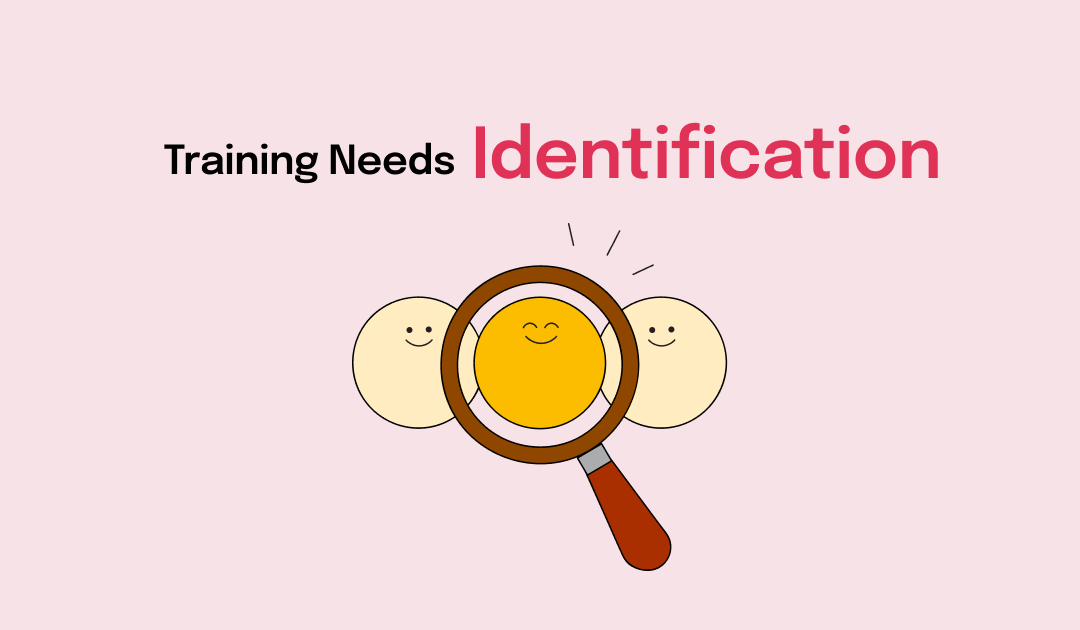Let’s start with a simple question: Why do we train people in the first place?
Training aims to bridge the gap between current and expected performance. Without knowing what those gaps are, training becomes an expensive shot in the dark.
In our work with organizations, we’ve seen that employee training needs assessment not only boosts performance but also increases employee engagement and retention. When individuals feel their learning and growth needs are being met, they are more likely to stay and contribute meaningfully.
Moreover, identifying individual training needs enables L&D teams to align learning efforts with strategic business goals, creating a measurable impact on the bottom line.
What Is a Training Needs Analysis?
Table of Contents
A training needs analysis (TNA) is the structured process of understanding what training is necessary for your employees to meet business goals efficiently. It identifies performance gaps at individual, team, and organizational levels and recommends training solutions.
TNA is sometimes confused with a training needs assessment, but here’s a quick way to differentiate the two:
Training Needs Analysis is a broader term that looks at training needs in the context of the entire organization.
Training Needs Assessment is a part of TNA that focuses on identifying specific learning requirements for individuals or teams.
Both are part of the training need identification process and equally essential in crafting high-impact learning interventions.
Benefits of Conducting a Training Needs Analysis
We have noticed several tangible benefits when organizations invest in conducting proper training needs assessments:
- Better employee performance
- Higher engagement and motivation
- Reduced turnover due to better career growth pathways
- Alignment of learning initiatives with organizational goals
- Optimization of training budgets
In essence, training needs for employees should be the starting point of any corporate training programs for employees. Without it, training is like driving blind.
Common Methods of Identifying Training Needs
There are several ways to determine training needs, and the best approach usually involves combining multiple techniques. Below are some best practices for assessing training needs of employees that we’ve successfully used:
1. Surveys and Questionnaires
A simple yet effective way to gather direct input. These can be employee-wide or role-specific and help understand both perceived and real gaps.
Use a training needs analysis survey to explore:
- Skills employees feel they lack
- Preferred training formats
- Topics they wish to explore more
2. Manager Feedback and Observations
Managers play a pivotal role in the identification of training needs in HRM. Their day-to-day interactions provide critical insight into employee capabilities and challenges. We recommend building leadership training needs into regular check-ins and performance discussions.
3. 360-Degree Feedback
This involves gathering feedback from multiple sources: peers, managers, direct reports, and sometimes even customers. This well-rounded approach helps surface blind spots.
4. Performance Appraisal Data
Analyzing historical performance data can reveal trends and areas for improvement. It’s one of the more objective methods of identifying training needs and should be used in conjunction with subjective inputs.
5. Job Analysis
This involves studying the tasks, responsibilities, and skills required for each role and comparing them with the current competencies of the employee.
This is key in identifying organizational training needs and making room for individual training needs analysis.
Steps of the Training Needs Analysis Process
Let’s walk through the stages of training needs analysis, based on what we’ve implemented for our clients:
Step 1: Define Business Goals
The first step in training needs assessment is to understand what the organization is trying to achieve. Are you launching a new product? Entering a new market? Undergoing digital transformation?
Strategic alignment ensures that training directly contributes to business success.
Step 2: Identify the Desired Performance
Define what “success” looks like for a specific role or team. For example, for a customer service team, success may mean increasing first-contact resolution rate or improving CSAT scores.
Step 3: Assess Current Capabilities
This includes using some of the methods discussed earlier – surveys, interviews, performance data, etc.
At this stage, organizational analysis in training needs assessment is vital to understand capability gaps that affect large sections of the business.
Step 4: Analyze the Gap
Compare the current capabilities with the desired performance to identify learning gaps. This is where training need identification methods come in.
Step 5: Prioritize and Plan
Every gap cannot be addressed immediately. Prioritize based on impact and urgency, then develop a training needs analysis plan with timelines, modes of delivery, and expected outcomes.
In our experience working with a range of corporate clients across industries, one of the most critical – and often overlooked – aspects of learning and development is identifying training needs accurately.
This first step sets the stage for everything that follows – from designing the right learning programs to evaluating their impact. Without a clear understanding of what your employees truly need to learn, even the best-designed programs can fall flat.
Let’s dive into the what, why, and how of this essential process.
Why Is It Important to Identify Employee Training Needs?
Imagine you’re building a bridge. Would you start without surveying the land, calculating the span, or identifying the materials required? Of course not.
The same principle applies to training in the workplace. Before launching into content creation or outsourcing a program, it’s essential to conduct a training needs analysis (TNA). This ensures alignment with actual gaps – not assumed ones.
In our work with L&D teams, we’ve seen that effective training needs assessment:
- Improves ROI on training initiatives
- Boosts employee performance and confidence
- Aligns workforce skills with strategic business goals
- Enhances employee engagement and retention
What Is Training Needs Analysis?
At its core, a training needs analysis is a systematic process of identifying the gap between current and desired knowledge, skills, and behaviors of employees. It ensures that training is focused, relevant, and aligned with organizational priorities.
A well-executed TNA also provides insight into:
- Team-level skill shortages
- Leadership training needs
- Individual training needs
- Organizational capability gaps
This enables L&D professionals to not only deliver impactful learning solutions but also to develop a talent pipeline, prepare for succession planning, and support strategic workforce planning.
The 3 Levels of Training Needs Analysis
In our experience, the most effective training needs identification happens at three levels:
1. Organizational Level (Organizational Analysis in Training Needs Assessment)
This focuses on aligning training goals with business strategy. Key questions at this level include:
- What are the long-term goals of the organization?
- Are there any new projects, tools, or systems being introduced?
- What are the upcoming market or customer demands?
Here, HR leaders often ask, “How does training help us stay competitive?” This is where a solid organizational training needs analysis helps create strategic L&D alignment.
2. Team or Task Level (Task/Functional Analysis)
At this level, the focus is on specific roles or departments.
- What competencies are required for success in this function?
- Are the current team members meeting expectations?
- What does success look like in this role?
In several client cases, we’ve conducted current training needs analysis for project teams adapting to agile workflows, resulting in targeted interventions that significantly boosted collaboration.
3. Individual Level (Person Analysis)
This zooms into each employee’s performance.
- Who needs training?
- What type of learning will close their specific gaps?
- How do we identify high-potential employees who can benefit from advanced development?
Tools like employee training needs surveys, performance reviews, or 360-degree feedback can help at this level. It’s here that you start tailoring training – an essential step for individual training needs analysis.
Methods of Identifying Training Needs
There is no one-size-fits-all approach. Depending on your organization’s size, culture, and maturity, a combination of the following methods of determining training needs can be used:
1. Surveys & Questionnaires
These are especially useful in identifying both individual and team-level needs. You can explore tools designed for training needs analysis surveys.
2. One-on-One Interviews
A qualitative approach, often used with managers or leaders, to understand team dynamics, aspirations, and gaps. Especially useful in leadership training needs.
3. Focus Groups
Group discussions uncover shared concerns and training themes. A great approach for assessing staff training needs in customer service or sales teams.
4. Performance Reviews
Analyzing past evaluations helps identify recurring challenges and growth areas.
5. Observations & Shadowing
First-hand insight into how employees perform their tasks. Works well when assessing training needs for employees in operational or field roles.
6. Skill Assessments
Using diagnostic tools or quizzes to assess proficiency levels. These are becoming increasingly common in digital training needs assessment models.
Common Training Needs in Modern Organizations
Based on the projects we’ve delivered across industries, here are some common training needs for managers and employees today:
- Leadership Development
(Especially for first-time managers or high-potential employees) - Communication Skills
(Both verbal and non-verbal, across hierarchies) - Change Management
(Particularly in companies undergoing transformation) - Collaboration and Teamwork
- Innovation and Design Thinking
- Time Management & Productivity
- Diversity, Equity, and Inclusion
Identifying these needs early allows for training needs analysis planning that is proactive rather than reactive.
The Process of Identifying Training Needs
Here is a simplified version of the training needs identification process:
- Define Business Goals
Tie learning directly to strategic outcomes. - Determine Desired Outcomes
What do you want employees to do better or differently? - Assess Current State
Use a mix of methods to gather data on current performance. - Analyze the Gap
Identify skill, knowledge, or behavioral gaps. - Prioritize Needs
Some skills are critical and urgent; others can wait. - Develop an Action Plan
Create a roadmap for learning journeys, including delivery formats.
This mirrors the stages of training needs analysis commonly used in the TNA training model.
When Should You Perform a Training Needs Assessment?
There’s never a bad time to perform a training needs assessment. But especially consider it:
- Before launching any major training initiative
- During periods of organizational change or restructuring
- After feedback from employee engagement surveys
- When new technologies or systems are being introduced
- As part of annual talent development or performance management cycles
In our experience, organizations that conduct training needs assessments regularly are far more agile and responsive to change.
What Tools Help with Training Needs Analysis?
Some commonly used training needs analysis tools include:
- Learning Management Systems (LMS) reports
- Skill matrix dashboards
- 360-degree feedback systems
- Competency mapping tools
- Online assessments and psychometric tools
Whichever you use, ensure that it supports the overall training needs assessment process – and not just adds to the documentation load.
Best Practices We Recommend
From our experience, here are some tried-and-tested best practices:
- Don’t assume – ask: What looks like a performance issue may be a motivation issue.
- Mix methods: Use both qualitative and quantitative approaches.
- Involve managers: They offer critical insights into real challenges.
- Be transparent: Explain the purpose of the TNA to employees.
- Use data to drive decisions: Make the case for training with evidence.
Real Takeaway for L&D Professionals
Identifying training needs isn’t a one-off task. It’s a continuous, evolving process that must stay aligned with your business objectives. When done right, it can help you build a high-performance, agile workforce prepared for both today’s and tomorrow’s challenges.
In our experience, the most effective training interventions start with clarity – clarity about who needs to be trained, what they need to learn, and why it matters.
As L&D professionals, the more we invest in understanding and identifying training needs of employees, the more strategic and impactful our role becomes.








